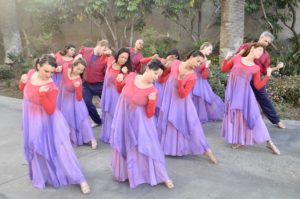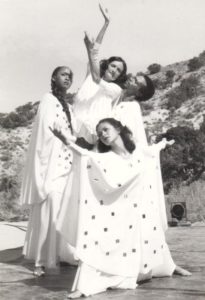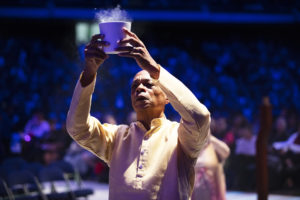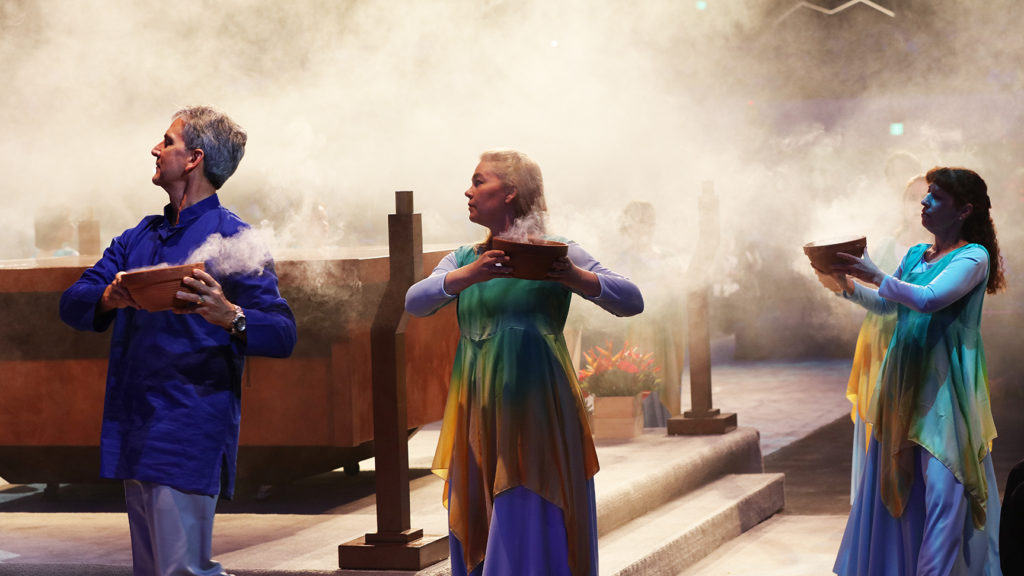When they enter the main floor of the Anaheim Convention Center on Friday morning for the opening event of this year’s Religious Education Congress (REC), the Valyermo Dancers will have a half century of history guiding their steps, putting graceful movement and prayer to accompany the proclamation.
History, and the staying power of John Thomas West.
The company’s founder, artistic director, and choreographer remains as much the company’s spiritual force now as he was in the summer of 1972. That is when he and four other original members provided liturgical interpretation for a Benedictine monks’ arts festival at St. Andrew’s Abbey in Valyermo, a town on the north side of San Gabriel Mountains where the Antelope Valley begins.
The Valymero Dancers have gotten around over the last 50 years, including Israel and Australia. They served at the Mass celebrated by St. Pope John Paul II at Dodger Stadium in 1987. The closest thing to home might as well be the Religious Education Congress, where they have appeared every year since 1976.
“People have interacted with me because of Congress and will tell me: ‘You touched me in ways I never imagined that could be,’ ” said West, a parishioner at St. Bernardine of Siena Church in Woodland Hills. “Gesture combined with words begins to produce a sense of meaning and a sense of connectedness to what it is.”

West worked as an educator and administrator in the LA area for three decades, including at Harvard-Westlake School in Studio City and The Mirman School for the Highly Gifted in West LA. Along the way, he earned a Master of Arts in Folklore and Mythology from UCLA with an emphasis in biblical literature and dance.
Liturgical dance, he believes, brings together skilled physicality with a discernment of Scripture inspired by changes in styles of worship that followed the Second Vatican Council in the mid-1960s.
“We’re a neuro-divergent population and not everyone processes the worship experience the same way,” said West. “Language isn’t enough. This is another dimension that puts flesh and bone on biblical characters. It makes them come to life — they weren’t just ideas in someone’s head. They had interactions and relationships you can build on.
“What did Abraham feel when he was about to sacrifice his only son? What was that tension and faith he felt with God challenging him? When you talk about ‘falling into you,’ in a hymn — what does that look and feel like, falling in love with God? Those are the things that so frequently drove me with this.”
The term “embodied prayer” is what West clarifies has always been part of a Catholic Mass experience, from the surrendering acts of genuflection or putting one’s hands together in prayer posture.
When those in the pews experience the Valyermo Dancers process up the center aisle, “even if they don’t physically move with us, they can move emotionally with us,” West said. “When you come to church, you don’t check your emotions at the door, you bring everything in and connect it all so that prayer is far more authentic, not just spouting words. You’re giving of yourself. It’s powerful to watch people cry and fall into your arms.”

The Valyermo Dance Company counts 30 members, 20 of whom remain active spread across the region from Lompoc to the South Bay. If it feels like a family affair for the dancers, it’s likely because West’s own family has made it one for so many years.
His wife of 48 years, Consuelo Zúñiga-West, is a founding dancer in the company and its producer, website manager. and general manager of events. Daughter Flavia Zúñiga-West, the assistant artistic director in recent years, has grown with the company since joining at age nine. Oldest son Dante Zúñiga-West also danced with the company and now works as an educator in Oregon.
West has an extensive training background with some of dance’s most renowned and influential teachers, and accepts that his company is “steeped in Benedictine spirituality.” His dance company’s ties to the religious order means that those in the company are also Benedictine lay oblates.
He credits the power of dance — its ability to keep one’s brain and body engaged in remembering sequences and then performing them — as the secret to looking so young for so long all these years.
“I admit it is harder to do some things with utter ease than I did them 30 years ago,” he said, noting that prior to the 2022 REC, he pulled tendons in his right foot during rehearsals and found himself in a boot for eight weeks.
As for the secret to the longevity of the dance company itself, Beth Newell said she’s figured it out: humility.
Newell, 65, who has been a member since 1995, is a parishioner at St. Lawrence Martyr Church in Redondo Beach and a founding member there of the liturgical dance group called Earthen Vessels for 40 years.
“The dedication of John and Consuelo has nurtured the company and kept it alive,” said Newell, who calls West an “athlete of God” with “a generous heart, and a creative spirit that would measure up to past Heisman trophy winners and gold medalists alike.”
Eve Jaquias-Johnson said joining the company as a student at Loyola Marymount 44 years ago helped her create the liturgical dance ministry of Padre Serra Church in Camarillo in 1990.
“As the first Filipino member of the company, I’ve been able to share a Pacific Islander perspective,” said Jaquias-Johnson, a coordinator for Asian and Pacific Islander liturgies at REC. “In the many special liturgies I have been a part of through the years, parishioners have always expressed appreciation for the expression of prayer through movement. Many have shared they were moved to tears.”
Greg Poteat was living in Palmdale going to St. Mary Church when he attended one of West’s mid-winter Sacred Dance workshops in 1987. He credits the opportunity to “creatively focus my energy in a positive way” and the support of his new community with helping him overcome the unraveling of his first marriage at the time.
Poteat understands how liturgical dance “seems to have its share of fans and foes, but I’ve always appreciated how John has helped the company members to understand the potential for some seated in the pews [to] be able to recognize the difference between ‘performance’ and ‘prayer.’ ”

Barry Barfield was invited by West in the late 1970s to join in the program, and then rehearsals. Eventually, he was hooked.
“Have you heard of that ‘God thing?,’ ” asked Barfield, who has a degree in theology from the University of San Francisco. “You’re not going to be a Valyermo Dancer unless this touches your ‘God thing.’ ”
Barfield, 68, was among those who returned for the company’s 50th anniversary celebration last Oct. 2 at Valyermo. There he made clear to West that “being part of the company was one of the greatest gifts of my life on so many levels.”
West said during the company’s recent jubilee he had people tell him they actually converted to Catholicism in part because of their experience seeing his company do their liturgical interpretation.
“I was moved greatly,” he said. “As hokey as it sounds, I believe the Holy Spirit has moved and worked through us in a variety of different ways.”

